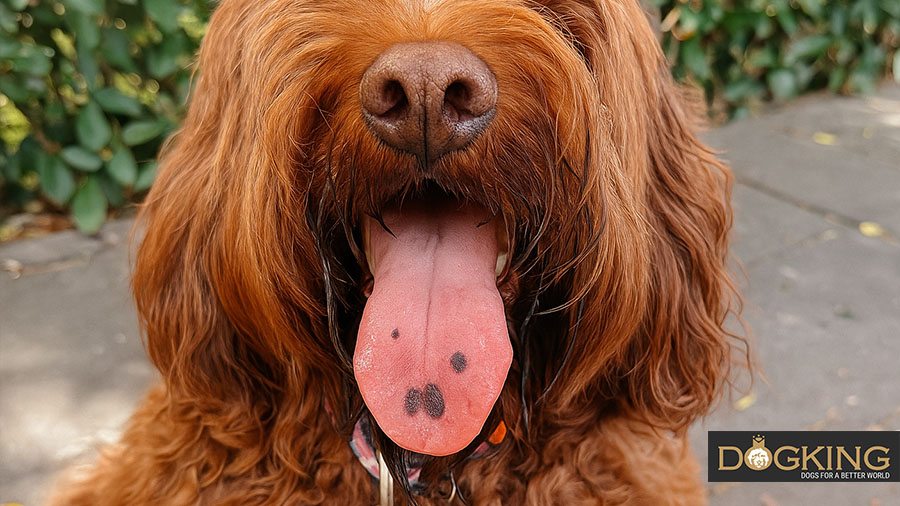Dogs' tongues: Is it normal for them to be black or spotted?
The colour of your pet's tongue can indicate changes in their health.

WHAT COLOUR IS A DOG'S TONGUE?
Estimated reading time: 6 minutes
Humans have pink tongues, so it may be surprising to find that your furry friend has a different shade in this part of their mouth. A dog's tongue can be pink, but it can also be black, bluish, purple or even mottled. You may have heard that only some breeds are born with a dark tongue, but the truth is that any dog, whether purebred or mixed, can have a blue or black tongue. It is true that some breeds are more likely to have this due to their genetic code, passed from parents to offspring. This colouration is the result of hyperpigmentation, or in other words, an excess of melanin, which is responsible for giving colour to the eyes, hair and, of course, your pet's tongue. This melanin accumulates in the form of spots which, in some cases, are so large that they end up covering the entire tongue.
Table of contents
1. Why do some dogs have blue or black tongues?
2. Which dog breeds have blue tongues?
3. When is black tongue in dogs not normal?
4. What does the colour of your dog's tongue mean?
Why do some dogs have a blue or black tongue?

As you already know, it is normal for some dogs to have a bluish or black tongue from birth. Specifically, this pigmentation appears around the 8th week of life, since right after birth all puppies’ tongues are pink. What happens in the body of dogs that experience this hyperpigmentation is an excess of tyrosinase, an enzyme responsible for catalysing the production of melanin. For this reason, these animals present a dark tongue, whether in shades of purple, blue or darker, almost black. In addition, this pigmentation can appear as a block, covering the whole tongue, or as spots or freckles, creating a unique design in each dog.
Which dog breeds have a blue tongue?

You probably know that purebred Chow Chows have a dark blue tongue that, in many cases, almost looks black. In other dogs, the tongue is mottled, with spots of different sizes across the surface. However, there are other breeds that display this pigmentation on their tongue and gums: the Shar Pei and its Mini Pei variant, and the Eurasier. All these dogs have a dark tongue from 8–10 weeks of age. In addition, other breeds such as Cockers, Retrievers, Shepherds, and Akitas are predisposed to having hyperpigmented tongues, although in reality any dog can present this trait.
When is a black tongue in dogs not normal?

If your dog has had a black, bluish, or spotted tongue throughout its life, there is no need to worry, as in this case we are talking about a completely benign hyperpigmentation that is part of its DNA. However, if this appendage of your furry friend has always been pink and suddenly dark spots appear or the whole tongue turns black, it is necessary to see a veterinarian. Sudden color changes in your dog’s tongue indicate a health problem that must be diagnosed as soon as possible. If the spots grow (in size or number), are raised or even ulcerated, it could be a serious issue. In this case, your dog will also be in pain, which you may notice in its difficulty eating. Other possible symptoms are bad breath, excessive drooling, facial swelling, and bleeding. If you observe any of these signs, go to the vet immediately, as it could be malignant tumors.
What does the colour of your dog's tongue mean?

When the colour of a dog's tongue changes quickly, it is a sign that something is not right in its body. There are different diseases and problems that can affect the colour of this part of your furry friend’s muzzle. For example, a white tongue may indicate a drop in white blood cells, which could be caused by anaemia (due to parasites, internal bleeding, etc.). On the other hand, purple colour on your dog's tongue, as long as it is not a normal congenital trait, means that it lacks oxygen, which is related to cardiovascular and respiratory problems. Other conditions that cause changes in the tongue’s colour include stomatitis, burns, warts and papillomas, and dehydration.
In short, if your dog has always had a black, blue or purple tongue, there is no reason to worry. It is part of its genetics and also of its particular charm and personality. However, if your dog’s tongue suddenly changes, spots appear that grow or change in appearance, along with the above-mentioned symptoms, you should consult a vet for an examination. In many cases, these spots may be benign, like human freckles, but it is worth ruling out melanomas in this area. It is also advisable to regularly examine your pet’s mouth and gums. Take advantage when your dog is relaxed with its mouth open and tongue out to check its appearance and colour. If you notice any strange signs, consult a vet as soon as possible. Whatever your beloved friend’s tongue looks like, keep it healthy and cared for so you can continue to enjoy its adorable loving licks.